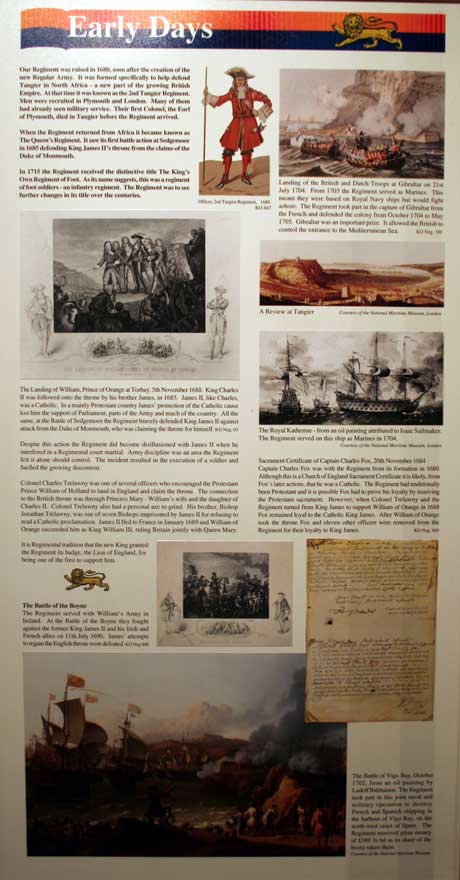Museum Display Information
The Raising of the Regiment

Our regiment was raised soon after the creation of the new Army. It
was formed specifically to help defend Tangiers, in Africa, a new part
of the growing British Empire. At that time it was known as the 2nd
Tangier Regiment. Men were recruited in Plymouth and London. Many of
them had already seen military service. Their first Colonel, The Earl of
Plymouth, died in Tangier before the Regiment arrived.
When the Regiment returned from Africa it became known as ‘The Queen’s
Regiment’ and saw its first battle action at Sedgemoor in 1685.
In 1715 the regiment received the distinctive title ‘The King’s Own
Regiment of Foot’. ‘Foot’ referred to the fact that the regiment was an
infantry regiment, with the soldiers fighting on foot. The regiment was
to see further changes in its title over the centuries.
The Landing of William, Prince of Orange at Torbay, 5th November 1688.
Accession Number: KO
King Charles II was followed onto the throne by his brother James in
1685. James II, like Charles, was a Catholic. His promotion of the
Catholic cause lost him support of parliament, parts of the army and
much of the country. At the Battle of Sedgemoor the Regiment bravely
defended King James II against attack from the Duke of Monmouth, who was
claiming the throne for himself.
The Regiment itself became discontented with James II when he interfered
in a Regimental court martial, which resulted in the execution of a
soldier.
Colonel Charles Trelawny was one of several officers who encouraged the
Protestant Prince William to land in England and claim the throne. His
brother Bishop Jonathen Trelawny was one of seven Bishops imprisoned by
James II for refusing to adopt the Catholic form of service. James II
fled to France in January 1689 and William of Orange succeeded him as
King.
It is Regimental tradition that the new King granted the Regiment its
badge, the Lion of England, for being one of the first to support him.
Accession Number: KO
The Battle of the Boyne
The Regiment served with William's Army in Ireland, against James and
his French allies at the Battle of the Boyne, on 11th July 1690. It was
here that James attempts to regain the English throne were defeated.
Accession Number: KO
Drum Skin from the Battle of the Boyne, July 1690.
Accession Number: KO2490/271
Landing of the British and Dutch Troops at Gibraltar on the 21st July
1704
From 1703 the Regiment served as Marines. This meant that they were
based upon ships of the Royal Navy but would fight on shore. The
Regiment took part in the capture of Gibraltar from the French and the
defence of the colony from October 1704 to May 1705. Gibraltar was an
important prize as it was a good defensive base and allowed the British
to control the entrance to the Mediterranean Sea.
KO Neg
Sacrament Certificate of Captain Charles Fox, 20th November 1684
Captain Charles Fox was with the Regiment from its formation in 1680. It
is likely that he was a Catholic, but this is a Church of England
Sacrament Certificate. The Regiment had traditionally been protestant
and it is possible Fox had to prove his loyalty by receiving the
protestant sacrament. However when Colonel Trelawny and the Regiment
left King James to support William of Orange, in 1689, Fox remained
loyal to the Catholic King James. When William of Orange took the throne
Fox and eleven other officers were removed from the Regiment for their
loyalty to King James.
Accession Number: KO0137/01
Illustrations:
 | The Royal Katherine, from an oil painting attributed to Isaac
Sailmaker. The Regiment served on this ship as Marines in 1704.
In the collection of the National Maritime Museum, Greenwich. |
 | The Battle of Vigo Bay, October 1702, print from oil painting by
Ludolf Bakhuizen. The Regiment took part in this joint naval and
military operation to destroy French and Spanish shipping in this
harbour on the north-west coast of Spain. In the collection
of the National Maritime Museum, Greenwich. |
 | Troops demolishing the mole and harbour installations at
Tangier, prior to the evacuation of the fort and defences in 1684,
from an oil painting by Dirck Stoop. In the collection of
the National Maritime Museum, Greenwich. |
 | A Review at Tangier---------- In the collection of the
National Maritime Museum, Greenwich. |
An officer of the King’s Own, 1680
Accession Number: KO 0642/02
© Images are copyright, Trustees of the King's Own Royal Regiment Museum.
You must seek permission prior to
publication of any of our images.
Only a proportion of our collections
are on display at anyone time. Certain items are on loan for display
in other institutions. An appointment is required to consult any of
our collections which are held in store.


